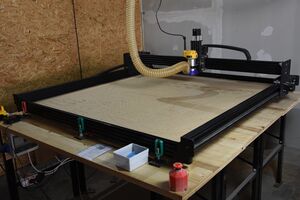WorkBee
WorkBee
| MachineInfoBox Ooznest WorkBee CNC | |
|---|---|

| |
| Synonyms: | DE: CNC-Fräse, CNC-Plattenfräse, Portalfräsmaschine |
| Type: | CNC Router |
| Material: | wood |
| Used with: | 6 mm, 8 mm, 1/4" or 1/8" end mills; some kinds of router bits |
| Location: | CNC Area |
| Access Requirements: | CNC Router Introduction |
| Status: | Broken |
| Firmware: | grbl |
| Software: | LaserWeb, Fusion360, see G-Code Sender |
| Manual: | product page, click "documentation" tab |
| Tutors: | Johannes |
| Similar (More or Less): | router, CNC mill |
Currently defective due to a buggy/broken controller board! See Issue #307
We have a 1500mm x 1500mm version of the WorkBee CNC router, which is based on the Openbuilds OX. It can currently cut sheet material of up to 50 mm thickness on a work area of approximately 1250 × 1250 mm. The surfaced (plangefräste) spoilboard area is 1260 × 1160 (x × y) mm.
Our plans for further improving it up can be found in our "WorkBee CNC" github project - maybe you would like to help?
Fusion Setup
Please make sure you add WorkBee.mch and grbl.cps to Fusion 360.
Router
The router mounted to it is a Dewalt D26200 (GB; known outside Europe as DWP611). You need to consider the sizes of its collets (Spannzangen) when buying your router bits.
- no-load speed: 16000 - 27000 rpm
- max cutter diameter: 30 mm
- available collet diameters:
- 8 mm
- 6 mm
- 1/4 inch (6.35 mm)
- 1/8 inch (3.175 mm)
The collets of the DW613, DW620 and DW621 also fit the router and are easier to get in Germany than the original ones.
| Dial Setting | Approx. RPM |
|---|---|
| 1 | 16000 |
| 2 | 18200 |
| 3 | 20400 |
| 4 | 22600 |
| 5 | 24800 |
| 6 | 27000 |
Spoilboard
Ooznest recommends a 6mm spoiler board, our first one is 20mm thick. It is mounted to the frame using 4 drop-in T-slot nuts. Cutting into the boards will make it uneven, from time to time it is neccessary to surface the spoiler board again.
The total size of the spoilboard is currently 1445 × 1370 mm.
When there is time, we would like to drill workholding holes into the spoilboard.
Electrics
The Machine received a full electrical overhaul in the first half of 2024, here are its current electrical specifications:
- Duet 3 6HC+ Mainboard running RepRapFirmware
- Web- and touch interface
- MT-2303HS280AW 2.8A NEMA23 Stepper Motors
- Dewalt D26200 Router
Dust Extraction
We have added a cyclone dust separator between the shop vac and the CNC router itself. Thereby, the bulk of the shavings and dust should be collected in an easily emptied box rather than the shop vac's bag.
The part that attaches the dust extraction hose to the router is called a "dust shoe". We are currently using this one designed by Patrick. The next version should ideally fit the dust extraction hose without an adapter and include a kind of transparent, flexible "skirt" to optimize the airflow.
Other interesting designs:
Workflow
This is just an overview and does NOT replace the personal introduction!
- create the tool paths in a suitable CAM software (e.g. Fusion 360)
- secure your workpiece on the machine's bed
- insert the appropriate collet & bit as defined in your tool paths
- turn the positioning motors on, home the machine and define the workpiece origin
- put on personal protection and turn the spindle on
- send the tool paths to the router in real time via the serial interface (USB)
- options can be found under "G-Code Senders"